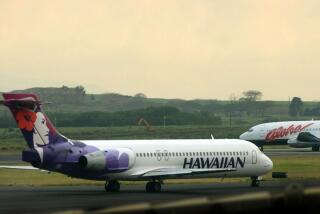‘Relatively Few Options Remain’ : Airline Merger Mania Expected to Abate
- Share via
NEW YORK — Most of the airline industry merger frenzy has passed, according to a prestigious Washington airline consulting firm, because there remain few likely candidates for acquisition.
“The airlines’ intense battle to position themselves for long-term survival is essentially behind us,” George James, president of Airline Economics Inc., said in an interview. “Many moves have been made, and relatively few options remain for more consolidation.”
James said 25 airline mergers have taken place since late 1985 and noted that four major carriers were acquired in 1986: People Express, Republic Airlines, Eastern Airlines and Western Airlines. A “major” airline is one with annual revenue of more than $1 billion.
Nine major airlines remain in the United States and each, James noted, has been involved in an acquisition in the past two years. The nine now have 95% of the market.
James spoke in conjunction with the publication of a book by Airline Economics titled “Airline Consolidation,” which contains facts about all of the combined carriers. It includes such information as the number of revenue passenger miles they fly, the number of aircraft they own and have on order, and the route miles of the merged carriers. There are also route maps.
Airline Economics executives declined to speculate on the remaining merger possibilities.
However, other airline observers place their bets on USAir, Piedmont Airlines and Pan American World Airlines--the three major airlines still regarded as unattached.
TWA Seen as Player
Trans World Airlines, which acquired Ozark Airlines last year but whose chairman, Carl C. Icahn, says he is seeking another merger partner, is also still seen as a player. Pan Am is said to be involved in merger discussions with several airlines, including American Airlines.
Avmark Inc., an aviation marketing and management service company in Arlington, Va., agrees in its January newsletter that these four carriers will still be involved in what it refers to as the “takeover maelstrom.”
It also predicts that a host of smaller airlines, including America West, Southwest, Alaska, Presidential, Aloha, Midway and Hawaiian, “are all targets for takeovers, willing or not.”
Airline Economics, in its “State of the U.S. Airline Industry--1987,” says airlines with long-term survival prospects must have six “critical” characteristics: several strong hubs with geographical spread and supported by feeder carriers; good yield management, or the ability to meet competitive pricing to maximize revenue; aircraft management, or the timely procurement of aircraft to meet route system requirements; low labor costs; a computerized reservation system, and the ability to take advantage of size, such the introduction of features such as frequent flyer programs.
Only five airline companies now possess these characteristics, Airline Economics said. They are United, American, Delta, Northwest and Texas Air., which owns Continental, Eastern, People Express and New York Air.
The consulting firm also predicted that airline industry operating profits will rise slightly in 1987 to between $1.6 billion and $1.8 billion. They are expected to be $1.4 billion in 1986 when all figures have been reported, about the same as in 1985.
More to Read
Inside the business of entertainment
The Wide Shot brings you news, analysis and insights on everything from streaming wars to production — and what it all means for the future.
You may occasionally receive promotional content from the Los Angeles Times.










